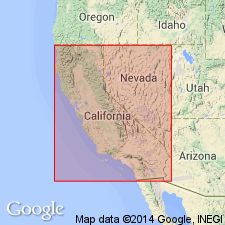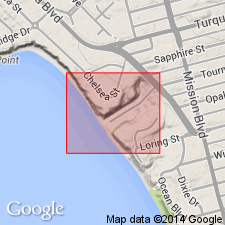
- Usage in publication:
-
- Mount Soledad Formation*
- Modifications:
-
- Named
- Dominant lithology:
-
- Conglomerate
- Sandstone
- AAPG geologic province:
-
- Peninsular Ranges province
Summary:
Unit is named after Mount Soledad as lowermost formation of La Jolla Group. Type section designated as being at head of natural amphitheater 400 m west of intersection of HWY I-5 and Ardath Road, San Diego Co., CA. Consists predominantly of cobble conglomerate which is interbedded with medium-grained sandstone in the upper part of unit. Is 70 m thick at type section. Unconformably overlies Cabrillo Formation; conformably underlies Ardath Shale (new) of La Jolla Group. Age is considered early(?) and middle Eocene based on stratigraphic relationship with Ardath Shale.
Source: GNU records (USGS DDS-6; Menlo GNULEX).

- Usage in publication:
-
- Mount Soledad Formation
- Modifications:
-
- Biostratigraphic dating
- AAPG geologic province:
-
- Peninsular Ranges province
Summary:
Mount Soledad Formation at the base of Eocene section may locally include strata of "Capay" age but faunal evidence is lacking. Few fossils from Mount Soledad Formation with locations are listed indicating "Domengine Stage". Correlation figure shows Mount Soledad Formation may be as old as early(?) Eocene and is definitely middle Eocene age.
Source: GNU records (USGS DDS-6; Menlo GNULEX).

- Usage in publication:
-
- Mount Soledad Formation*
- Modifications:
-
- Age modified
- Biostratigraphic dating
- AAPG geologic province:
-
- Peninsular Ranges province
Summary:
Age of the Mount Soledad Formation is revised from early(?) and middle Eocene to: middle Eocene on the basis of fossils [pollen and spores]. This agrees with age determinations based on planktic foraminifers (Steineck and others, 1972).
Source: GNU records (USGS DDS-6; Menlo GNULEX).
For more information, please contact Nancy Stamm, Geologic Names Committee Secretary.
Asterisk (*) indicates published by U.S. Geological Survey authors.
"No current usage" (†) implies that a name has been abandoned or has fallen into disuse. Former usage and, if known, replacement name given in parentheses ( ).
Slash (/) indicates name conflicts with nomenclatural guidelines (CSN, 1933; ACSN, 1961, 1970; NACSN, 1983, 2005, 2021). May be explained within brackets ([ ]).

